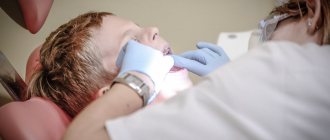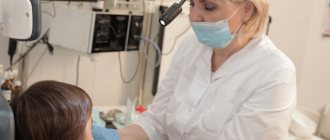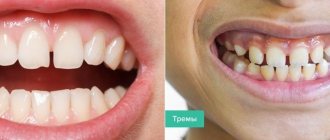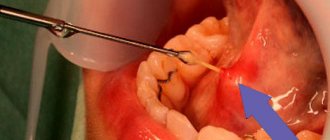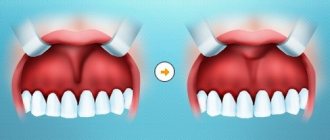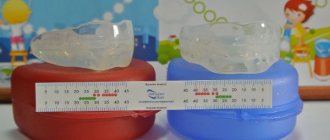How does primary infection occur?
Often, the initial infection with a herpes infection has no symptoms and is not noticeable. But it happens that complications appear along with herpes:
- gingivostomatitis - inflammation of the oral mucosa and gums;
- an increase in temperature, accompanied by the appearance of blisters and ulcers in the mouth;
- herpetic panaritium (inflammation of the finger tissue) - the infection can spread to the fingers if they are pulled into the mouth;
- rashes can occur throughout the oral cavity, affecting the gums, which turn red and bleed. The child refuses to eat because the process becomes painful.
Why is it important to respond to signals?
Nonverbal signals are one of the two main ways (along with baby crying) of a baby’s communication with the outside world. With their help, he tries to communicate his well-being and needs. The child’s body language allows adults to notice that he, for example, is tired, hungry, or wants to play. He may also report that he is tired of some activity and it’s time to take a break or do something else.
When others correctly recognize the baby's body language and respond promptly to the signs he gives, the baby feels safer. Thanks to this, the emotional connection between him and his parents is strengthened, which is vital for the normal development of the child.
“The older children get, the more signals they can give to adults,” says psychologist and lactation consultant Alexandra Slautina. - As a rule, at first they give implicit signals, which parents cannot always read. The older the child becomes, the wider the range of these signs. For example, a tired baby may first rub his eyes, turn away from adults and only after that start crying. Sometimes parents miss these signs and start putting the baby down when he is already crying. In this case, you have to calm him down first.”
How to fight a “cold”?
If herpes appears for the first time or in a baby under 6 months, and the disease is accompanied by fever and affects not only the lips, then you need to consult a pediatrician for antiviral therapy.
Often recurrent infections go away on their own. But you can shorten their duration by using local antiherpetic agents (active ingredient acyclovir).
Ways to reduce discomfort:
- apply a cold compress to the area of the rash;
- avoid sour and spicy foods;
- choose cool drinks;
- if there is severe pain, then use ibuprofen or paracetamol;
- Do not use products containing lidocaine due to possible side effects or overdose.
How to prevent the spread of the virus:
- it is important to ensure that the child does not scratch the rash and wash his hands;
- use individual dishes, towels, toothbrushes for a child with a herpes infection;
- during an exacerbation, you should not engage in contact sports;
- a child with a “cold” on his lips should not kiss other people.
What signs do babies give us?
The nonverbal cues that babies use to express their emotions and desires are largely universal. However, each child develops his own unique set of gestures with which he communicates with loved ones.
As parents get to know their baby better, they learn to decipher these signals and better understand what the baby wants and how the baby is feeling.
By analyzing how the baby reacts to the actions of adults, you can find out, for example, how best to calm him down: smile at him, talk to him, sing a song. By observing the baby, adults can more accurately choose how to behave in difficult situations for him, for example, if he is experiencing sensory overload.
"I'm tired!"
The following nonverbal signs will help you understand that your baby needs rest:
- distant look;
- sudden movements of arms and/or legs;
- yawning, rubbing eyes with hands;
- finger sucking;
- loss of interest in people and toys.
If you notice signs of fatigue in your baby, it's best to start putting him to bed.
"I am hungry!"
Newborns can be attached to the breast 12–20 times a day. The following signals will help you determine that your baby is hungry:
- he smacks his lips;
- opens his mouth;
- sticks out tongue;
- looks for his mother with his eyes or buries himself into his mother's breast when he is in her arms.
The combination of these signs is enough to understand that it is time to feed the baby. By observing him, you will see signs of readiness to feed even before he starts crying.
It is better to learn to recognize the signs of hunger in a baby in time and feed him on demand, than to wait a certain time each time.
“If adults fail to notice the first signs of hunger in time, the child may begin to grunt and worry, putting his fist or fingers in his mouth. And only after that he makes himself known by crying. When this situation repeats over and over again, he learns to immediately scream and cry to say that he is hungry,” notes Alexandra Slautina.
"I want to play!"
In the first month of life, a newborn sleeps and eats a lot. The older the child, the more active and willing he is to play. You can tell that your baby is ready to play by the following signs:
- the eyes are wide open and shining;
- eye contact with an adult (if you are busy with something, the baby watches you with interest);
- smile;
- movements become smoother;
- the child reaches out to you.
If you see that the baby doesn’t mind playing, then it’s time to smile at him and talk to him. Playing with babies does not require large expenses or special skills; the main thing for a child in this process is to interact with significant adults.
"I need a break!"
From the age of four months, babies no longer always feel sleepy after playing. Instead, they sometimes seek to change the type of activity or reduce the intensity of stimuli coming from the outside world. Your baby can communicate that he wants to do something else in the following ways:
- turns away from the adult;
- covers ears or eyes with hands;
- squirms or kicks.
If you see that your child needs a break, give him the opportunity to spend time in a quiet environment or do something else. For example, if he turns his head away from the rattle you give him, try laying him on his back and observing his movements.
Cleft lip and palate: the defect can be corrected
Cleft lip and palate is one of the most common congenital malformations of the upper jaw: it occurs in a third of patients with congenital malformations. In Moscow, 1 in 800 babies are born with this developmental defect.
The anomaly is usually detected by ultrasound in the 1st-2nd trimester of pregnancy. Such news is a huge stress for future parents. But in most cases, thanks to timely and qualified treatment, cosmetic and functional defects in the baby can be eliminated.
At what age is surgical treatment most effective and how a complex anomaly is treated, Elvira Sergeevna Mkrtumyan, a maxillofacial surgeon and plastic surgeon at the Morozov Children's Hospital, told.
What influences the formation of a defect?
The defect is formed in the first two months of the child’s intrauterine development, when the formation of the facial skeleton occurs. The cause of the development of pathology is a chromosome abnormality.
The development of the defect is influenced by both hereditary factors (7%) and external factors (40%). External ones include infectious and viral diseases, smoking, drugs, alcoholism, the use of certain medications, lack of vitamin folic acid, poor ecology, and so on.
What types of clefts are there?
Clefts can occur in both the lips and palate. They, in turn, can be isolated (only the lips or only the palate) and through, when the defect extends to the upper lip, alviolar process and palate. Each type has varying degrees of severity. In addition, the defect can be either unilateral (usually on the left) or bilateral.
With an isolated cleft lip, as a rule, the deformation may be minor, or may be accompanied by deformation of the nasal septum, alar cartilage and alveolar cleft, which subsequently leads to dental problems.
With cleft palates (from minor clefts of the soft palate only to severe bilateral lesions of the soft and hard palates), children may have problems with eating, breathing, sucking, and subsequently with sound pronunciation. Thanks to timely surgical intervention, it is possible to obtain an ideal treatment result.
The most severe form is bilateral through cleft lip and palate. But even in this case, timely treatment and rehabilitation give the baby a chance for recovery.
If, during intrauterine diagnostics, a cleft is discovered in the baby, what should parents do?
The most important thing I would like to say to parents who are faced with this problem is that there is no need to worry. It is important to immediately consult with maxillofacial surgeons involved in the treatment of pathology.
We advise future parents even before the baby is born. We tell you how to feed your child correctly - it is better with a spoon or a bottle with special nipples in order to preserve swallowing reflexes, because with prolonged tube feeding they can fade.
Often this defect can be accompanied by pathology of the bone and cardiovascular systems, kidneys. Therefore, it is important to undergo tests immediately after birth to rule out these diseases. If the baby does not have other serious concomitant diseases, we prescribe planned surgical treatment to eliminate the defect.
At the request of the parents, after the maternity hospital, the child can be transferred to the neonatology department of our hospital, where the mother will be taught how to feed the child, examined and given recommendations for management before a planned operation.
At what age is surgical treatment most effective?
The optimal age for surgery to correct a cleft lip and eliminate nasal deformity, if there is no gross pathology among other systems, is 3 months. Earlier plastic surgeries do not provide the opportunity to obtain the best aesthetic result.
If the child has a severe form of cleft, correction can be carried out in two stages. At six months, if it concerns the palate, it is the soft palate; from one to two years, it is the hard palate. If surgical treatment is carried out in one stage, then it is performed at the age of 9 months to 1.5 years. This has a number of advantages: the child endures one rather than two anesthesia, the tissues are more mature, which means the treatment result will be more effective. We recommend palate plastic surgery for children under two years of age, until the child’s brain—the center of speech—has formed incorrect speech.
If the child has a severe form of cleft, correction can be carried out in two stages. At six months, if it concerns the palate, it is the soft palate; from one to two years, it is the hard palate. If surgical treatment is carried out in one stage, then it is performed at the age of 9 months to 1.5 years. This has a number of advantages: the child endures one rather than two anesthesia, the tissues are more mature, which means the treatment result will be more effective. We recommend palate plastic surgery for children under two years of age, until the child’s brain—the center of speech—has formed incorrect speech.
What operations are performed for cleft lip and palate?
Correction of a congenital anomaly requires an integrated approach. It is aimed not only at eliminating a cosmetic defect, but also at reconstructing functional disorders, eliminating problems with swallowing, breathing and sound pronunciation. The volume and type of operational benefit depends on the characteristics of each child and is selected individually.
If the cleft looks like an isolated lip or palate, surgical treatment will be performed in one stage. In the most difficult cases, correction is carried out in several stages.
For isolated cleft lip without significant deformation of the nose, cheiloplasty is performed. The vestibule of the oral cavity (the space located under the upper lip) is created, the integrity of the orbicularis muscle of the upper lip is restored, and a red border is formed. If the upper lip defect is more severe, then a one-stage cheilorhinoplasty (lip and nose surgery) is performed. We perform lip plastic surgery and place the alar cartilages of the nose in a symmetrical position. On the 7th day, postoperative sutures are removed and the children are discharged from the hospital with recommendations for further management of the child.
An isolated cleft palate manifests itself as an anatomical damage to the soft palate (mobile palate) or the soft and hard palate. The pathology is accompanied by impaired swallowing, breathing and sound pronunciation. Palate plastic surgery involves restoration of the hard palate and soft tissues of the velum, and closure of the alveolar process. After the operation, when children reach 3 years of age, classes with a speech therapist are recommended to prevent speech disorders, manifested by nasality and unintelligibility of speech.
If speech disorders are not eliminated through the efforts of speech therapists alone, then there is a surgical correction - elimination of velopharyngeal insufficiency. The operation involves transplanting flaps on a pedicle in the area of the pharyngeal ring.
From the age of 5, a child is sent for treatment to an orthodontist to eliminate defects in the dentofacial system. At the end of orthodontic treatment, the next stage of surgical treatment is performed - bone grafting of the alveolar cleft to eliminate the bone defect of the alveolar process.
The Morozov Children's Hospital has accumulated extensive experience in the effective treatment of cleft lip and palate. Every year, doctors perform up to 200 operations to correct these congenital malformations.
The causative agent of herpes on the lips
Herpes type 1 is part of the DNA family. It is because of this that, having become infected with this virus for the first time, a person will become a carrier of this disease for life.
Infants and children under 3 years of age usually do not become infected due to the immunity they receive from their mother. Children become susceptible to the disease from the age of 3-4 years. At the same time, by the age of five, most children (60% to 80%) already have immunity to herpes. Infection occurs from parents who are carriers of the virus or from other children.
Let's talk about how an infection can occur in a child. If we talk about herpes on the lips, the reasons for its occurrence in children are as follows:
- unbalanced diet;
- lack of one or more vitamins and microelements in the body;
- stressful and other negative emotional situations, including mental and mental stress;
- severe manifestations of allergies;
- hypothermia or overheating outdoors;
- constant colds, frequent illnesses, the presence of chronic ailments.
Treatment of herpes on the lips in children
To find out how to treat herpes on the lips of a child, it is better to visit a specialized clinic as soon as possible. Here, the optimal treatment regimen will be individually selected for you, taking into account the condition of the little patient’s body. However, we can tell you in advance how the treatment will proceed and what medications may be prescribed.
These are the following drugs:
- immunostimulants;
- antiviral drugs;
- interferons.
The disease should be combated at the first sign of infection. This is a guarantee of a prompt and successful recovery. If herpes is not treated, it can develop into a complicated or chronic form. Then relapses will become common. Treatment here consists of reducing symptoms and suppressing the manifestation of the viral infection. Since it will not be possible to completely remove herpes from the body, everything must be done to reduce its manifestations to a minimum, as well as to minimize the activity of the disease virus. The specialist should prescribe ointments, tablets, antipyretic drugs.
For babies up to the first year of life, ointments and gels are prescribed as therapeutic agents. Older children are prescribed tablets and, in special cases, injections. Healing medications and antiseptics are also prescribed.
An immunologist prescribes immunostimulants. These funds are needed so that the baby’s body actively fights the infection and so that herpes does not affect other areas of the mucous membranes and internal organs.
Interferons are needed to destroy the infection and to prevent its uncontrolled reproduction. They come in the form of tablets and suppositories.
You may have to contact specialists in the future. This virus is not eliminated from the body. It tends to periodically escalate. At this time, your child may feel a certain discomfort in his health, unpleasant sensations. Doctors' recommendations will help alleviate this uncomfortable condition for the child. They will not only prescribe you medications and a diet, but will also tell you what kind of lifestyle your baby should have. Most often, specialists, in addition to medications, prescribe proper and balanced nutrition and vitamin complexes. They may also recommend taking appropriate antiviral drugs and immunostimulants during influenza epidemics.
Diagnostics
During your initial visit, you can visit a pediatrician or dermatovenerologist. However, if the disease often recurs, you should be examined by an infectious disease immunologist. He will make a qualified conclusion after all diagnostic measures. If the diagnosis is confirmed, antiviral drugs and immunostimulants are prescribed. The course of the disease is monitored by a specialist without fail. He will monitor whether positive changes have occurred. Periodic observations with a doctor will help keep the situation under control. Parents should not do this on their own. The child needs to undergo regular examinations for changes in well-being. In addition, after the first diagnosis, doctors will advise how to choose the baby’s diet and prescribe other measures that can improve the child’s condition. You can get diagnosed by an immunologist as soon as the first symptoms of an unpleasant illness appear. It is better to prevent the disease than to deal with its consequences and complications, especially since it is impossible to remove this virus from the body.

